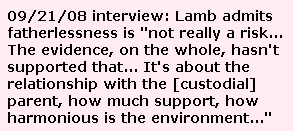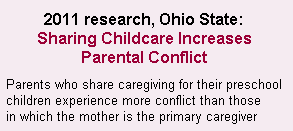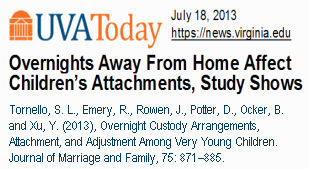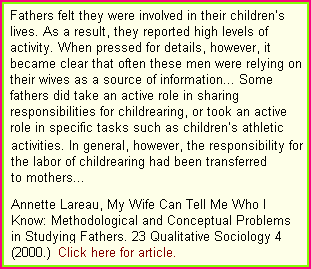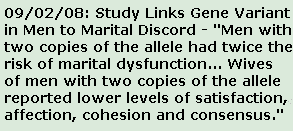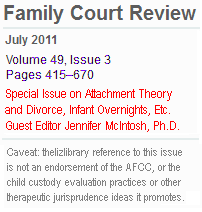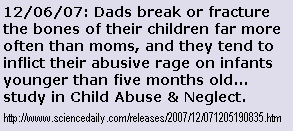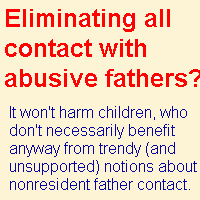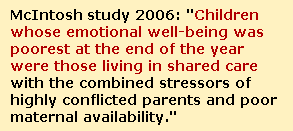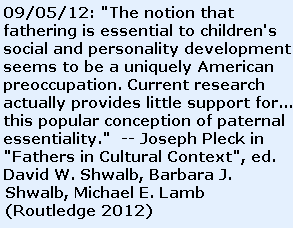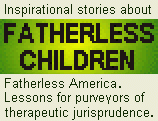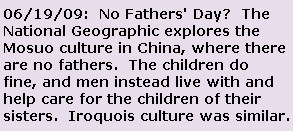|
SEE ALL MYTHS AND FACTS PAGES This page is http://www.thelizlibrary.org/liz/017.htm SEE NATIONAL FATHERHOOD INITIATIVE MYTHS (Distortions, Propaganda and Outright Lies)
FATHERHOOD
AND FAMILY LAW: In blue: what the pundits, spin-meisters, and study summarizers SAY the studies have found (frequently interposed with could-bes, should-bes, what-ifs, comments, faulty conclusions, and suppositions without cites), and, in black: what the research actually says! Myth -- A father's involvement is crucial for the well-being of a child. Fact: "While it would be a seemingly obvious proposition to most of us, that fathers' consistent and substantial involvement in child care would benefit the child, this appears to have not been well established. The relationship between paternal involvement and children's well-being seems to be mediated by a number of other conditions that involve the father, the mother, and the child. In other words, increased paternal involvement does not automatically result in improved child outcomes. Nor is it clear whether the father's involvement provides unique nurturance that can not be as readily provided by substitute caregivers."
Fact: "In 38 studies published since 1990, researchers examined linkages between children's well-being and their relationships with nonresident fathers. In general, these studies do not provide strong support for the belief that visitation with nonresident fathers benefits children. Of the 24 studies that included data on the frequency of contact, only 10 (42%) found that contact significantly predicted some aspect of children's well-being. Other studies focused not on contact but on how close children feel to their fathers. Of these 10 studies, only 3 found significant associations in the predicted direction. Taken together, these studies suggest that the frequency of visitation and children's feelings about their fathers are not good predictors of children's development or adjustment."
Fact: A 2012 study examining non-resident fathers' involvement, mothers' parenting and stress, and children's behavioural and cognitive development in low-income single-mother families found "indirect" benefits from fathers' payment of child support and good quality parenting because these influenced the mothers' parenting, which had a direct effect. However, "expected associations between fathers' contact and child outcomes [were] not found in this sample".
Fact: "[P]aternal involvement is likely to have predominantly positive consequences only when it is the arrangement of choice for the particular family."
Fact: "Research on the impact of father involvement on children provides evidence that high levels of paternal participation tends to increase children's cognitive competence, empathy, and internal locus of control. These children are also characterized by reduced sex-stereotyped beliefs. However, these positive outcomes may result because of the fact that the fathers sampled wanted to be and enjoyed being involved in childcare, not just because they were involved per se."
Fact: "[I[nfants with less involved fathers were significantly more attached to their mothers than were infants with highly involved fathers."
Fact: "The salutary effects of being raised by two married, biological parents depend on the quality of care parents can provide. Using data from an epidemiological sample of 1,116 5-year-old twin pairs and their parents, this study found that the less time fathers lived with their children, the more conduct problems their children had, but only if the fathers engaged in low levels of antisocial behavior. In contrast, when fathers engaged in high levels of antisocial behavior, the more time they lived with their children, the more conduct problems their children had. Behavioral genetic analyses showed that children who resided with antisocial fathers received a "double whammy" of genetic and environmental risk for conduct problems."
Fact: In a study of groups of cooperative, parallel parenting, and single parent households, where fathers were helpful to and supportive of mothers in an amicable relationship, children tended to have fewer behavior problems and were more attached to their fathers. [liznote: this likely is a combination of good genes and unstressed mothers]. Otherwise, the study did not support findings of benefits of father involvement: "Children in the cooperative coparenting (good divorce) cluster had the smallest number of behavior problems and the closest ties to their fathers. Nevertheless, children in this cluster did not score significantly better than other children on 10 additional outcomes. These findings provide only modest support for the good divorce hypothesis.
Fact: "Public attention and social policies have focused on fathers living apart from their children because of rising concerns about the consequences of this arrangement for child well-being (Cabrera & Peters, 2000). A father's absence from the household, however, does not necessarily mean that he is absent from his child's life (King, 1994). A significant number of nonresident fathers still maintain ties with their children (Amato & Sobolewski, 2004), and recent evidence indicates that when fathers maintain an active presence in their children's lives and foster close bonds with them, their children appear to benefit (Amato & Gilbreth, 1999)."
Myth -- Children in the custody of single fathers show more life satisfaction than children in the custody of single mothers [and "were found in a large Denmark study to do better on 26 measures of well-being" -- Warren Farrell].
Myth -- Fathers do a lot more child care than they used to. Fact: "It appears, from a variety of data sources, that most fathers still do very little child care, especially when the children are very young. To be sure, there has been a change in the meaning of fatherhood, as reflected in both the attitude and the behavior of fathers, largely as a result of a general shift in less gender-specific family roles (Thornton and Freedman, 1983; Stein, 1984). But, Pleck (1985) and others, who have done extensive research on this question, have concluded that most of these changes have been relatively modest."
Fact: "[W]hen husbands care for children while their wives work, a majority of men resist the arrangement, and in the face of such resistance, these women are more likely to quit work than are women who use other modes of childcare."
Fact: "One review of various studies of intact, two-parent families found the ratio of mothers' to fathers' contribution to be 10:1 in responsibility for a child's daily activities, 2:1 in availability, and 3:1 in parent-child interactions."
Myth -- Now that so many women are in the work force, fathers and mothers share domestic work more equally. Fact: "Comparative studies have consistently found that women perform the lion's share of housework... Despite the huge imbalances... scholars have been surprised by the relatively low prevalence of perceptions of injustice on the part of women... The interplay of the three legitimizing principles (time availability, resource dependence, and gender ideology) and the inequality of household division of labor is decisive. Inequality leads to perceptions of inequity when the woman encounters low time availability (i.e., is strongly involved in the labor market), when resource dependence is low, and when the woman adheres to a nontraditional gender ideology." Michael Braun, Noah Lewin-Epstein 2, Haya Stier 3* Miriam K. Baumgärtner. Perceived Equity in the Gendered Division of Household Labor. Journal of Marriage and Family Volume 70 Issue 5, Pages 1145 - 1156 (2008).
Fact: "Physical and emotional care for young children at night was largely provided by women, with a lack of explicit negotiation between partners about who provides this care, even when women return to employment... Fathers did not, in general, undertake this fourth night-time shift. Those that did were more likely to be the fathers of young adult children who were staying out late at night, with the focus of their concerns being the safety of their children."
Fact: "Despite the presence of some "equal sharer" couples, Deutsch's study echoes others in finding that most husbands do relatively little domestic labor of any kind compared with their wives. Scholars estimate that no more than 20 percent of dual-income couples share domestic work equally. "
Fact: "Mothers with one or more children age 5 or older spend, on average, 6 hours a week on child care. Fathers average 2 hours per week. Mothers with one or more children under age 5 spend, on average, 17 hours a week on child care. Fathers average 5 hours per week. [BUT] 24 percent of married females and 51 percent of married males say they and their spouses take care of the children an equal amount."
Fact: Fathers in intact U.S. households spend, on average, less than thirty minutes per day in one-on-one time with their children.
Fact: "Although we had suspected that maternal employment might be a pervasive moderator of fathers' caregiving activities and sensitivity, we did not find this to be the case. In the case of the current analyses, it did not appear that the factors associated with fathers' involvement were fundamentally altered by mothers' employment."
Myth -- There has been a cultural reversal in recent decades in which both women and men now find their primary fulfillment in outside work, rather than in the home. Fact: "[P]ooled data from the 1973-1994 General Social Surveys indicate that in working families, women have shifted away from finding work more satisfying than home toward finding home a haven. Moreover, were it not for women's growing labor force participation and the changing distribution of marital status, the shift would have been even larger. Men's relative work-home satisfaction has been stable. Finally, finding work a haven is unrelated to weekly working hours, and it has not contributed to any increases in working hours over time."
Myth -- A new study showed that men's testosterone levels reduce when they become fathers, proving that men are naturally nurturing. Fact: The study did not measure nurturing ability or child care. It did not measure tranquility. It did not in fact measure or show that "spending time with kids" reduces fathers' testosterone, because there was no baseline comparison measuring the more nurturing fathers with other fathers prior to their becoming fathers. "We hypothesized that T would decrease after men interacted with their children but found that T did not change during a 30-minute father-child interaction." All the study actually showed is that there is evidence that testosterone (like other hormones) can be influenced by environmental cues. Even this, however, was not consistently established, as changes in the study subjects' hormonal levels were not linear. The study's abstract, including the authors' speculations, as well as the widespread media reports are grotesquely misleading. [An alternate hypothesis is that the offspring of men who became less dangerous and didn't kill or abandon them or their mothers had an evolutionary survival advantage.]
Myth -- Fathers do more housework in households in which their wives earn more than they do. Fact: When wives out-earn husbands, the women not infrequently take on even more of traditional "women's work" when they are at home, serving the men in an attempt to ward off the men's resentment, and to compensate for their higher economic power with conciliatory behavior, while the men not infrequently compensate with more macho attitudes.
Myth -- Fathers do more housework in households with children. Fact: "[F]athers spend substantially more time in domestic and child care activities in households when mothers are employed, but men still fall far short of assuming an equal load. More interestingly, men in families with young children do less than those in households with no children or with older children."
Fact: "[M]en who are least committed to their relationships spend the least time on housework, whereas women's housework time is not affected by marital intentions."
Myth -- If men do less childcare, it is because they are busy working. Fact: "Men spend more time volunteering and providing informal support [to others, and the community] than they do caring for children."
Fact: Working women first shave time from their own personal activities when there is a deficit because of employment or other factors, not from the children.
Myth -- Fathers living with children tend to work fewer hours than other men. Fact: "Contradicting our expectations... we find that presence of coresident children is not associated with fewer hours worked per week... In fact, it appears that men who are fathers of dependent children, regardless of their living arrangements, averaged more hours per week than fathers of older children and men who were not fathers. The good provider role appears to be most salient for coresident fathers."
Fact: Fathers work more outside the home upon the birth of a child, and almost twice as much more upon the birth of a son than upon the birth of a daughter.
Fact: New research confirms that the pattern continues in 2006: "Being a father has little effect on men's working patterns, in spite of the fact that they cut back their working hours for a short time after a new child is born, according to Economic and Social Research Council funded research at the University of Bristol. "There is no evidence that 'new,' involved fathers are adopting a 'female model' of parenthood, with part-time work and high levels of child care..."
Myth -- Fathers spend much more time with their children than they used to.
Fact: "75% of married resident mothers went shopping with their adolescents in the past 4 weeks compared to 26% of married resident fathers. In other words, married resident mothers were three times as likely as married resident fathers to engage in this form of parental involvement, a large effect size."
Fact: There has been a push over the past decade to prove that a new fatherhood is emerging. The research remains in accord, albeit finding that fathers are now spending somewhat more time than previously. The research finding this increase is invariably flawed. For discussion, see article here. Myth -- Mothers spend less time with their children than they used to. Fact: "Modern women spend about the same amount of time per day in primary care of all their children compared with their counterparts in the 1920s. Modern women, however, spend twice as much time per child on primary child care, primarily because they have fewer children and are better educated than mothers in the 1920s. Looking at fathers, the researchers found that in 1985 dads spent about 26 minutes a day in primary child care, up from 21 minutes in 1975, or an increase of about one-fourth. (Information on fathers is not available from the 1920s.)"
Myth -- Fathers may be around their children fewer hours, but when they are, they spend more one-on-one and quality time with them. Fact: "Baydar and Brooks-Gunn (1991) argue that even when men do spend a substantial amount of time with their children, the quality of involvement is not high, and therefore fathers' involvement is not an important or necessary element of children's development."
Fact: "Findings revealed that mothers were more knowledgeable about adolescents' peer relationships than were fathers, that mothers with daughters reported the most peer-oriented activities, and that both mothers and fathers spent more time with same-sex adolescents and their peers."
Myth -- A significant portion of fathers improve in their parenting, and become more involved and interested in their children as a result of divorce. They are known as "divorce-activated dads". Fact: This is a myth promulgated by the custody evaluator industry, who also like to assert that by contrast, mothers' parenting capacity diminishes upon divorce. It's a specious claim, designed to facilitate pro-father joint custody recommendations. Parenting practices are unrelated to divorce. "[T]here are more similarities than differences in parenting among recently divorced and continuously married parents."
Myth -- Improved father-child relationships post-divorce are associated with long-term improved child outcomes post-divorce. Fact: "Although not common, 14% of the adolescents studied experienced improved father-offspring relationship quality following divorce. Analyses revealed that compared to offspring who maintained a poor relationship with their father, those experiencing an increase in closeness were less likely to have pursued post-high school education, more likely to become a parent, and more likely to be cohabiting."
Myth -- Children are faring much worse now than in past decades. Fact: "In recent years, the lives of America's children have improved in measurable ways, according to a new collaborative report from federal agencies. America's Children 1999 shows that youth are less likely to smoke, die and or be victimized by crime, but they have made fewer gains in areas that predict their economic futures... Among the report's most positive results is a 40 percent drop in serious violent crime involving juvenile offenders since 1993." Some indicators of child wellbeing have gone down; but others have gone up.
Fact: "[N]eglect is the most common form of intentionally fabricated maltreatment [and] anonymous reporters and noncustodial parents (usually fathers) most frequently make intentionally false reports. Of the intentionally false allegations of maltreatment... custodial parents (usually mothers) and children [are] least likely to fabricate reports of abuse or neglect."
Fact: "On the basis of research that has been conducted so far, it is difficult to support an assertion that there are high rates of false allegations of sexual abuse consciously made by mothers in divorce situations."
Fact: "[F]alse charges are infrequent, and every allegation must be taken seriously."
Fact: "[W]hile allegations might be increasing, they are hardly rampant... [and] these cases are not limited to accusations against fathers. Indeed, mothers accused the child's father in only half the cases. The rest involved third parties, mothers' new partners, stepfathers, and others. Nor did we find that sexual abuse allegations in contested cases were more likely to be unfounded than in cases in the general population. In half the cases with allegations, abuse was believed to have occurred, and in 17 percent no determination was reached by either a court evaluator or CPS worker. Even when the allegation was unfounded, most of the experts we interviewed believed the reports were made in good faith."
Fact: "Large scale studies show that sexual abuse allegations occur in only 2 percent of all disputed custody and access cases. Of those 2 percent, only 8 percent were found to be false, and furthermore, mothers were no more likely than fathers to make false allegations."
Fact: When allegations of neglect are included in the statistics, the rate of intentionally fabricated claims in the context of custody cases rises to 12%. "[F]athers most frequently make intentionally false reports [while] mothers and children [are the] least likely to fabricate reports of abuse or neglect... [D]eliberate fabrication of abuse by custodial parents is relatively low, alleviating the concerns that there is a widespread problem of custodial parents trying to manipulate the legal system or seek vengeance against their former partners...diverting attention from the more prevalent problems of unsubstantiated allegations made in good faith and unresolved investigations where suspicions of abuse or neglect remain but cannot be confirmed.
Fact: Fathers are 16 times more likely to make false allegations than are mothers..
Myth -- Mothers frequently make false allegations of domestic violence in order to gain advantage in custody litigation. Fact: Research does not substantiate this popular myth. However, research does substantiate that there is no tactical advantage to making domestic violence claims. Fathers are more likely to get visitation when domestic violence is alleged, even in states with custody presumptions enacted to protect battered women. Abusive athers are more likely to obtain primary custody when domestic violence is present, alleged or not. Mothers who have suffered domestic violence fare even worse in custody disputes when the state has friendly parent provisions.
Fact: "[O]ur central finding was that child custody and access processes provide opportunities for abusive partners to exert power and control over their partners and children, and that these opportunities were often supported by policies and practices of service providers."
Myth -- Family courts are biased against fathers in custody disputes. Fact: "Despite the powerful stereotypes working against fathers, they are significantly more successful than is commonly believed. The Massachusetts [gender bias] task force, for example, reported that fathers receive primary or joint custody in more than 70 percent of contested cases."
Fact: "The various gender bias commissions found that at the trial court level in contested custody cases, fathers won more than half the time. This is especially significant in light of the fact that not only do fathers win more often in court when they take these cases to trial, but also that an overwhelmingly higher percentage of fathers gain primary custody -- by any means -- than were ever the primary caregiver of their children during marriage. Statistically, this dashes the argument that 'only the strongest cases are taken to trial,' and in fact indicates an extraordinary bias against mothers and the value of mothering and mothers' work."
Myth -- Fathers who fight for custody of their children are likely doing so because they are their children's primary caregivers. Fact: "Abusive fathers are far more likely than nonabusive parents to fight for child custody, not pay child support, and kidnap children."
Fact: "Since batterers know that nothing will devastate the victim more than seeing her children endangered, they frequently use the threat of obtaining custody to exact agreements to their liking. Custody litigation becomes yet another weapon for the abuser, heightening his power and control tactics to further terrify the victim."
Fact: "[M]any men who initiate custody and access challenges through the family law court system do so in order to harass or maintain control over their ex-spouses."
Myth -- Mothers who fight for custody of their children are likely doing so because they want to live off the child support payments. Fact: As of 1994, noncustodial fathers contributed only 19 percent, on average, of their children's household income."
Myth -- Mothers who fight for custody of their children are likely doing so because they are controlling and vindictive. Fact: Mothers are more likely to prefer joint custody when they perceive their ex-husband to be more competent as a parent. Control and guilt over divorce does not correlate with custody preferences.
Myth -- Fathers who fight for custody are likely doing so because they want to participate more after the divorce in their child's primary care. Fact: "Most men who fight for custody or access do not want a larger role in the day-to-day caregiving, but rather a larger role in decision-making related to their children and ex-spouses' lives. A Canadian study of fathers' rights groups found that members of these groups expected mothers to assume primary responsibility for children, whereas fathers spoke of 'helping.' Not one father in the study talked about wanting to have the responsibility of the everyday care of his children.'
Fact: "The author concludes that men's perceptions of the divorcing procedure and postdivorce familial arrangement leaves them feeling hurt, confused, vulnerable, and insecure. The men then turn to established constructions of masculinity to subdue these feelings and to redefine their position as one of lost legal rights rather than emotional trauma. In general, these efforts centered around the relationship with the former wife, suggesting that the thrust of divorced men's identity establishment is focused on resistance and revenge."
Myth -- Fathers withdraw from involvement post-divorce because of conflict in the relationship with mothers. Fact: "In contrast to the hypothesis that parental conflict might negatively interfere with nonresident father involvement, we found conflict over childrearing to be unrelated to father involvement (and the association was in the positive direction)." (In other words, more father involvement = more conflict.)
Myth -- A father can engage in domestic violence against his spouse but nevertheless be a good father and role model for his children. Fact: "[N]ot only is violence in families pervasive but that both the children who are victims of violence and those that witness violence that occurs between their parents suffer a great deal and are themselves at risk of using violence as adults (Jaffe, Wolfe & Wilson, 1990; O'Keefe, 1995; Pagelow, 1993; Saunders, 1994; Johnson ,1996)...infants suffer from having their basic needs for attachment to their mother disrupted or from having the normal routines around sleeping and feeding disrupted... Older children come to see violence as an appropriate way of dealing with conflict... These children can suffer from serious emotional difficulties..."
Fact: "The sheer prevalence of the problem of violence and the dynamics surrounding it make it clear any assumptions about equal partnership in these cases are out of the question... the majority of women never report the assaults or in fact ever tell anyone about it (Johnson, 1996) and thus may not be believed if the first time the issue is raised is at the point of separation... may avoid going to court out of fear of retaliation, a fear which is not unfounded given the data on the escalation of violence at separation... agree to whatever the husband wants in an attempt to pacify him... as an exchange for custody... may appear unstable or emotional while their batterers are perceived as confident, rational and economically secure (Rosnes, 1997)... all the research flies in the face of what Rosnes argues is presently happening in the courts: '...judges assume that wife abuse is not necessarily damaging to a child, and that being violent does not necessarily affect a father's parenting ability.... Similarly, research showing how battered women give up legal rights, and how women and children are at risk during unsupervised access visits and transfer is also upheld.' (Rosnes, 1997 at 33). "
Myth -- Men and Women are equal perpetrators of "domestic violence." Fact: They may be "equal perpetrators" of "domestic violence" as that term is from time to time defined, but they aren't equally battered spouses. "That there are as many male victims of violence as female... is a significant distortion of well-grounded research data. Indeed, men are hit by their wives, they are injured, and some are killed. But, are all men hit by women battered? No... it is misogynistic to paint the entire issue of domestic violence with a broad brush and make it appear as though men are victimized by their partners as much as women. It is not a simple case of simple numbers. The media, policy makers, and the public cannot simply ignore -- or reduce to a parenthetical status the outcomes of violence..."
Myth -- Custody evaluations help prevent relitigation of parental disputes about "parenting timeshare" and related issues. Fact: Studies indicate that parents who are subjected to the forced and artificial arrangement of their families by third party evaluators have two to two and a half times the rate of relitigation of parents who do not undergo the custody evaluation process.
Fact: "In the state of paranoia that comes with marital separation, it is difficult for parents to realize that no one (including their spouse or a new step-parent) can take their relationships with children away from them. The hallmark of attachment relationships is their durability. Neither physical separation nor death terminates attachments."
Fact: "In terms of involvement frequency, mothers tend to be more involved than fathers, and even nonresident mothers engage in as wide a range of activities with children as do most resident fathers. Moreover, in the multidimensional scaling analysis, parent gender accounted for approximately 95% of the variance between parent categories in patterns of involvement. Macrostructural, normative, internalized, and even biological aspects of the gender system may allow, encourage, or sanction mothers to participate in a wide range of activities and forms of communication with their adolescent children, irrespective of living arrangements. Regardless of the explanation, and despite changing attitudes about the role of fathers, our study indicates that parent gender continues to be the key factor shaping parent-adolescent involvement patterns."
Myth -- Fathers are equal parents. Fact: "[T]here seems to be compelling evidence of a change in the contemporary meaning of fatherhood for men, but not so much that men have become equal partners in parenthood."
Fact: "Often during the marriage both spouses work to maintain the fiction that power is shared or, more palatably, that power is simply not an issue. However, gender is very much about power. In our society, gender serves as the basis of a hierarchical system of male dominance and female subordination... Marital power differences are obscured by the dominant ideology of the companionate marriage."
Fact: Men believe women do less childcare than women actually do, and men believe they are more involved in childcare than they are in reality.
Fact: "[W]hile most fathers report the intention to increase the levels of involvement with their children over those of previous generations, actual behavior does not generally match expectations."
American Psychological Association
Guidelines for Psychological Practice with Lesbian, Gay, and Bisexual Clients (2011), Guideline 8.
http://www.apa.org/pi/lgbt/resources/guidelines.aspx
[liznote:This isn't about sexual orientation.
It's obviously about the sex of
the parent. That women are better parents is a strong enough determinant to create measurable
results when multiplied by two in research assessing both heterosexual couples and homosexual
couples. And now reported -- or rather, buried -- in the APA LGBT Practice Guidelines,
where it's more politically correct to say so, is
the official APA position and recognition of this fact.] Fact: "Relative to differences in parent-child interaction by family type, there are much larger differences by parents' gender, with many fathers minimally involved in their children's lives, regardless of the father's residential status (Parke & Sterns, 1993). In postdivorce families, although there is wide variation in fathers' involvement, contact tends to be infrequent, diminishes over time (King, 1994; Maccoby & Mnookin, 1992), and decreases further as a stepfather enters the children's lives (Seltzer, 1991)."
Myth -- The role of fatherhood has substantially changed in recent decades. Fact: "Despite exceptions we all know, most husbands 'help out' at home, leaving employed wives to perform between 70-80 percent of the housework."
Fact: "Resident mothers, especially those of adolescents with nonresident fathers, remain the most involved. In contrast, nonresident fathers are the least involved parents, particularly when adolescents also have a nonresident mother. Among fathers, unpartnered resident fathers are rated highest by adolescents on parental involvement, especially in the more traditionally female-oriented items such as shopping and talking about social events and problems, although they were no more involved overall than nonresident mothers."
Fact: "The 'new father' remains more fiction than fact. Apparently the culture of fatherhood has changed but not the practice. Only a few studies report increases in paternal involvement in recent decades. The few men who do increase their parental activity do so mostly in the area of play -- not assuming a full range of parenting responsibilities. Men and women in middle-class famillies use different standards to measure and explain away fathers' limited involvement in parenting, thus sustaining the myth of egalitarianism. As they do with household labor, wives tend to underestimate their parenting activity, and husbands tend to overestimate theirs."
Fact: In 45% of two-parent households, women provide half or more than half of the household income; in single parent households, women provide more than half to all of the income 82% of the time. In 88% of households, women are charged with the responsibility for family care.
Myth -- Mothers cannot substitute as a role model for boys. Fact: "[I]t appears from the research findings that children do not appear to imitate people of their own gender any more than the opposite gender, nor do they typically end up resembling the same-sex parent more than the other. It seems, therefore, that men are unlikely to construct their fatherhood identity on the basis of male role models, only."
Fact: Mothers and fathers influence their children in similar ways with regard to the development of morality, competence in social interactions, academic achievement, and mental health.
Myth -- Boys need fathers in order to learn how to be good husbands and fathers. Fact: "Most boys who grew up with single mothers have positive opinions of them. They are likely to have 'experienced' the process of disassociation from women much less strongly than boys from father-mother households. An overwhelming number of boys and men under thirty who like and admire their mother are those who grew up, for most of their childhood years, with their mother as the sole head of the household... It is increasingly clear that the great majority of these boys also grow up to have better relationships with women, a different sexual persona, from boys/men from most mother-father families. They are usually more free in conversational style, listen with more interest to what women say, and see women as individuals first rather than 'women' first. In short, they are more comfortable with women, and identify much more. They are not afraid of solidarity with a woman, or of trusting her. This is not because there is something wrong with 'men,' or heterosexual reproduction, but because we live in a society which still has feudalistic ideas of 'family.' "
Fact: "The essentialist perspective assumes that boys need a heterosexual male parent to establish a masculine gender identity. Pleck (1995) has demonstrated that empirical gender research does not support this assumption... Lytton and Tomney (1991) concluded that 'very little about the gender of the parent seems to be distinctly important'. "
Myth -- Fathers tend to copy their own father's parenting styles. Fact: "Those who adopt a nontraditional model of fatherhood are equally likely to have had fathers who were relatively unavailable, unloving, and powerless or have modeled themselves after fathers who were also highly participant in their own upbringing (Radin, 1981; Sagi, 1982)."
Myth -- Fathers are the parent more likely to be the primary disciplinarian of the children. Fact: Contrary to popular belief, fathers are not the main disciplinarians of their children; mothers are, particularly in the early years.
Myth -- Just because a father has had an abusive relationship with his wife doesn't mean that his behavior is harmful to the children or that he isn't a good father to his children. Fact: "A child who witnesses domestic violence is more likely to grow into a perpetrator or victim of domestic violence than a child who was himself or herself abused."
Fact: "A study by Kalmuss (1984) contributes to this conventional wisdom and research. Using data from a "nationally representative sample" to explore whether there is a relationship between experiencing or witnessing violence in the family of origin on the one hand and perpetrating violence against one's spouse on the other, Kalmuss' results indicate that those who observed violence between their parents were more likely to perpetrate violence against their spouse than those experiencing violence as a teenager. Sons and daughters were equally as likely to be victims as perpetrators after witnessing their fathers hitting their mothers. The intergenerational transmission of this behavior appears to be role-specific, i.e., children who observe violence between parents may come to see it as acceptable behavior between spouses but not against kids. Frey-Angel (1989) suggests that observation of violence perpetuates the cycle in the next generation."
Fact: "[B]iological
fathers were more likely to physically abuse their partners than were stepfathers
or other men, and... children were more likely to witness IPV if it was
perpetrated by their biological father instead of a stepfather (Sullivan
et al., 2000)...
Myth -- Children are at greater risk of physical abuse in single mother households than in single father households. Fact: Children are at greatest risk of physical abuse in a household with a biological parent who is cohabitating with a paramour. However, "[a]mong children in single-parent households, those living with only their fathers were approximately one and two-thirds times more likely to be physically abused than those living with only their mothers."
Myth -- Children are more likely to be physically abused by their mothers than by their fathers.
Myth -- Youth from "fatherless homes" are at higher risk for substance abuse. Fact: Youth living with two biological or adoptive parents are significantly less likely to use alcohol, tobacco, and illegal drugs, or to report problems with their use, than youth not living with two parents. "[However] the highest risks of youth substance use, dependence, and need for illegal drug abuse treatment are found in families with a father and stepmother. Risks of youth substance use, dependence, and need for illegal drug abuse treatment are generally higher among youth who live with a biological father and a stepmother than among youth who live with a biological mother and a stepfather. Youths who live with a biological father and no mother or stepmother are more likely to use substances, to be dependent on substances, and to need illegal drug abuse treatment than youths who live with a biological mother and no father or stepfather."
Myth -- "Fatherlessness" places children at risk of numerous developmental problems. Fact: "Likewise, the controversial family
structure studies that Hart cites which suggest differences in fathers' and mothers' contributions to child development are irrelevant and flawed.
For example... data that finds that delinquency is twice as high in cases where the father is absent than when he is
present... no such problem has been found in studies of lesbian two-parent families. Thus, we can safely deduce that
the elevated rate of delinquency does not result from 'fatherlessness'... recent evidence suggests that delinquency
rates are lower when the mother is alone with her son than when she has invited another man to live with her... such
negative outcomes are even less common when she has invited a woman to live with her (Tasker and Golombok 1997;
Brewaeys et al. 1997). The clear implication is that what places children at risk is not fatherlessness but the
absence of the resources that a qualified second parent can provide...
Myth -- The original common law solution of granting custody to fathers showed that society used to understand that fathers were equal child caregivers. Fact: "Prior to the twentieth century, the legal status of women and children was tantamount to that of chattel. Married women could not enter into contracts, own or manage their own property, work in many professions, or even vote. That fathers got to keep what they 'owned' on divorce indicates nothing about actual caregiving, and tells us only that the power and status imbalance between men and women was extreme. In fact, after the relatively rare divorce, just as after the relatively common death of mothers in childbirth, the children actually were cared for and nurtured by older female siblings, aunts, grandmothers and other relatives, stepmothers, and household help."
Fact: "Direct paternal involvement in childrearing is a radical departure from almost all historical patterns of family structure."
Fact: [O]nly 100 years ago, 20% of women were killed by childbirth (or some related complication) and 20% to 50% of infants died during the first year of life... Until the 19th century... children were often considered worthless possessions --'just another mouth to feed'... often unwanted (no birth control), treated coldly (no cuddling and bonding), swaddled, and even beaten regularly and terrorized (some religious folks thought they had to drive out Satan and 'the stains of original sin') ...there have always been lots of single-parent families (caused by death); women have always worked outside the home (as servants and in the fields).
Fact: "[I]t would be a mistake to exaggerate or romanticize colonial men's involvement in family life. Although men could be attached to and indulgent of very young children, there is no evidence to suggest that they engaged in the daily care of infants or toddlers. Diapering, feeding, bathing, cooking, and other everyday tasks of childcare were left to wives, older daughters, or servants."
Myth -- The Industrial Revolution changed fathers' parenting roles. Fact: Fathers' parenting roles did not change during this period any more than they varied in prior centuries from time to time and place to place and with the family circumstances of different kinds of families. What shifted in the late 19th century, along with the rise of the suffrage movement, was a social focus that began to consider child well-being to have priority over father's traditional rights to and ownership of child labor. "Fathers in nonindustrial subsistence economies generally play a relatively small role in the care of young children."
Myth -- Research shows that children do better the more contact they have post-divorce with nonresidential fathers. Fact: "Limited research has been conducted on the relationship between child outcomes and involvement of fathers who do not live with their children. Most of this research has focused on the provision of formal child support and the frequency of father-child contact. Divorce and nonmarital childbearing do not preclude fathers from being actively involved in their children's lives. [However] while the percentage of children living apart from their fathers has increased in recent decades, little national-level research has been conducted on the role that fathers living apart from their children play in their lives, and the relationship between nonresident father involvement and child outcome."
Fact: "Existing research is mixed about whether the continuing involvement of nonresident fathers is important to children's lives. Several large-scale studies have found no association between the amount of contact a non-custodial father has with his children and an assortment of measures of child well-being (King, 1994; Furstenberg, Morgan, and Allison, 1987). Other studies, however, have found continued contact to be related to improved psychological scores, fewer behavioral problems, and better peer relationships (Peterson and Zill, 1986; Wallerstein and Kelly, 1980)."
Fact: Nonresident father's involvement appears to correlate with children's increased academic performance in grades 1-12. However, this generally holds only when resident mothers are not very involved. "This association weakens when mothers' involvement is included in the model."
Fact: "The physically close but psychologically distant parent-child interaction seemed to affect the child's behavior detrimentally, whereas children with physically and psychologically close interaction with their parents showed less behavioral problems... " Children did better where the family boundaries were clear. "In the families where there was a lot of confusion in the family boundaries both the physical and psychological involvement of the father with the family and the children was occasional and often caused problems. The parents interacted with each other only because of the children, but they had nothing else in common... In the well-functioning families where, according to mothers' reports, both the mother and the children had accepted the physically absent father inside the family boundaries the children had fewer behavioral problems."
Fact: "While public sentiment has been in favor of nonresident father's involvement in family life, there is limited research evidence of whether their involvement yields positive benefits for children (King, 1994) and for the functioning of the biological family unit... most studies, particularly those based on large national databases, have not been able to detect a significant connection between the nonresident father's contact with his child and the child's well-being (Furstenberg et al., 1987; King, 1994). In a study which did find an association between absent-father involvement and child well-being, it was found also that father contact was beneficial only to the degree that both parents got along fairly well (Hetherington et al., 1978)."
Fact: "Research findings on the association between frequency of father-child contact and child outcomes are mixed. In general, large-scale studies find no relationship between father-child contact and child outcomes, such as cognitive development, academic achievement, behavior, and perceptions of academic competence and self-worth."
Fact: "The weight of evidence does not support the view that higher levels of child-nonresidential father contact are automatically or always beneficial to children."
Fact: "Some research suggests that contact between children and fathers who do not live together is associated with fewer behavior problems and improved psychological well-being. However, other studies have found that father contact has a detrimental effect on children's math scores, delinquency, and behavior problems. This suggest that frequency of contact may be less important to child well-being than the quality of the father-child relationship."
Fact: "Divorced fathers help their children more by consistent payment of their child support than by the number of visits made to their children."
Fact: "[P]aternal contact was unrelated to several measures of well-being, including the presence of delinquency, academic difficulty, distress (including feelings of loneliness, depression, or anxiety), and dissatisfaction (with self, family, friends, etc.)."
Fact: In families formed by black adolescent mothers, "[t]he presence of a father inside the home provide[d] only a modest advantage for children's well-being. Contact, even regular contact, with fathers outside the home had little effect on positive youth outcomes."
Myth -- Joint custody, or otherwise Involved nonresident fathers help buffer children from the negative effects of depressed or unhealthy mothers. Fact: "Consistent with existing literature, we find that maternal depression and anxiety are associated with greater risk of child behavior problems. The results also suggest that the presence of two unhealthy parents is associated with more child behavior problems, but only among resident father families. Unhealthy fathers who live apart from their children do not directly influence children's behavior problems. Nor do these men, when healthy, buffer their children from the deleterious effects of an unhealthy mother."
Myth -- Increasing fathers' visitation time and custody rights makes them more amenable to paying child support. Fact: "As researchers began to stop collecting their data mainly from fathers and began to explore the relationship between visiting and paying child support in longitudinal studies, the theory that increased visitation would result in increased child support compliance began to wane. In 1993, the Office of Economic Research, U.S. Bureau of Labor undertook a study based on the National Longitudinal Survey of Youth (NLSY). The NLSY is a survey of more than 12,000 men and women who are interviewed annually since 1979. The authors of this study found contrary to previous studies, increases in visitation have no effect on changes in child support."
Myth -- Research on single mother households proves that divorce harms children. Fact: "[W]e find that family structure does operate through economic status because, once income is controlled, the family structure effects primarily disappear for both behavioral and cognitive outcomes... Children with higher quality home environments (with respect to emotional support and cognitive stimulation) have fewer behavioral problems and higher cognitive test scores. The stress hypothesis receives virtually no support from our results. Children raised in families that experience multiple transitions do not consistently have higher levels of behavioral problems or lower test scores than do children in family types with one or fewer transitions, even when only child characteristics are controlled... Finally, maternal psychological well-being is shown to be an important mechanism by which family structure affects behavioral outcomes, but not cognitive ones."
Fact: "[T]he effects of marital disruption are often collapsed with single parenting or female-headed households. Distinctions are not made between the homes of never-married women and divorced and separated women.... More basic studies and secondary analyses are needed... to support the sweeping generalizations that are made about the impact of father absence from a relatively small core of data. "
Fact: "[T]the absence of a male role model following divorce is much less significant than the economic, emotional, and psychosocial consequences of family disruption in explaining the negative effects of divorce on children."
Fact: Parents' history of adolescent delinquency not only predicts their later divorces, but also "parents' personal behavior and personality characteristics have a greater impact on their children's behavior than does their married, never-married, or divorced status."
Myth -- Research on single mother households proves that "fatherlessness" harms children. Fact: "The relative well-being of children in bereaved families and the poorer outcomes identified among children in step-families suggest that the absence of a parent figure is not the most influential feature of separation for children's development."
Fact: "[F]ather absence does not significantly influence the level of well-being of either daughters or sons. Rather... children's perceptions of their relationships with both parents have a more direct influence on their psychological well-being than does the physical presence or absence of their father."
Fact: "T]here is little evidence to support the hypothesis that nonresident father involvement has positive benefits for children."
Fact: "Using data from subsets ranging in size from 777 to 1,501 children from the child supplement to the National Longitudinal Survey of Youth (NLSY), a series of multivariate regression models were tested to determine whether the effects of nonresident father involvement on child well-being vary by race, mother's education, or whether the child was born within or outside of marriage. The results show few interactive effects, and no identifiable set of conditions emerged that increased or reduced the importance of father involvement for child well-being."
Fact: "Meta-analysis supports the notion that the impact of father absence appears to be mediated by family conflict; father absence in itself may not affect children's well-being. The family conflict perspective was strongly confirmed by the data. This perspective holds that children in intact families with high levels of conflict should have the same well-being problems as children of divorce, and the data supported this hypothesis."
Fact: Serious design errors and methodological problems make many studies ostensibly showing harm from father absence inconclusive, e.g. the impact of family-related variables (number of children, sex of parent, cause of parental absence, etc.)
Fact: "A growing body of scientific literature demonstrates that children who grow up with 1 or 2 gay and/or lesbian parents fare as well in emotional, cognitive, social, and sexual functioning as do children whose parents are heterosexual. Children's optimal development seems to be influenced more by the nature of the relationships and interactions within the family unit than by the particular structural form it takes."
Fact: "Literature reviewed in this report overwhelmingly supported the notion that father absence has a detrimental effect on children. However, the results of this study did not support the conclusions..."
Myth -- Boys are especially harmed by divorce. Fact: "[The] absence of a parent figure is not the most influential feature of separation on children's development; the age at which children experience separation is not, in itself, important; [and] there is no consistent evidence that boys are more affected by divorce than girls."
Myth -- Research on single mother households proves that they are bad for children. Fact: "[D]espite our efforts to identify the strongest possible measures of living arrangements and family change, in only one instance -- the relationship between having lived in a solo single-parent family during adolescence and the risk of premarital pregnancy -- was there even weak evidence that family structure had a direct effect that persisted above and beyond that associated with neighborhood disadvantage and residential mobility."
Fact: "Researchers have been energetic in studying family structure and attempting to identify family environments that facilitate or inhibit children's development and well-being. The consistent pattern, however, is that family structure per se tells us little about children's adjustment. Amato and Keith's (1991) meta-analysis of 92 (mostly North American) studies found a small advantage favoring children in two-parent families over their peers in divorced single-parent families, with a median effect size of .14 of a standard deviation."
Myth -- Children [may] do better in joint custody arrangements post-divorce (Wallerstein & Kelly, 1980). Fact: Whoops, no... this hypothesis hasn't held. (Wallerstein & Blakeslee, 1989).
Myth -- Children do better in joint custody arrangements post-divorce! Fact: "Research indicates that joint physical custody and frequent child-nonresidential parent contact have adverse consequences for children in high-conflict situations. Joint physical custody and frequent child-nonresidential parent contact do not promote parental cooperation."
Fact: "There are two key rationales which underlie and promote the concept of joint physical custody: one comes from a concern for the child, and it holds that equal or frequent access to both parents is in the best interest of the child (Wallerstein & Kelly, 1980). The surprising result, however, from studies of voluntary joint custody arrangements undertaken in the 1970's is that this rationale was disproved: 'Two years after divorce, children are no better adjusted than children raised in sole custody households. Despite more access to both parents, joint custody children show neither less disturbance nor better social adjustment than sole custody children' (Wallerstein & Blakeslee, 1989, p. 271)."
Fact: "[A]lmost no studies have examined paternal adjustment on children and no studies have examined the 'effect and interaction between both parents' adjustment, conflict, time with both parents, and residence' on children (p.37). With respect to access and closeness to the noncustodial parent on children's adjustment, the evidence is mixed or inconclusive. Finally, custody status by itself does not affect children's adjustment following a divorce."
Fact: "Enthusiasm for joint custody in the early 1980's was fueled by studies of couples who were highly motivated to 'make it work' (Johnston, 1995). This enthusiasm has waned in recent years, in part because of social science findings. For example, Johnston (1995) concluded from her most recent review that 'highly conflictual parents' (not necessarily violent) had a poor prognosis for becoming cooperative parents and there is increasing evidence that children of divorce have more problems because of the conflict between the parents before the divorce and not because of the divorce itself (Kelly, 1993). 'High conflict' parents should be allowed to develop separate parenting relationships with their children. Frequent visits and joint custody schedules led to more verbal and physical abuse. More frequent transitions between high-conflict parents were related to more emotional and behavioral problems of the children.
Fact: "While there was no clear evidence that either joint or sole custody promotes better child adjustment (and there were no differences found between effects of mother-only and father-only custody), a link was consistently found between frequency of visitation/transitions between parents and maladjustment. Children shuffled more frequently between parents were more exposed to and involved in parental conflict and aggression and were more often perceived by both parents as being depressed, withdrawn, uncommunicative, and/or aggressive. These findings, the authors note, are consistent with the findings of other studies."
Fact: "The majority of studies based on large national surveys in the United States, found little association between father visitation and children's well-being."
Fact: A study done in 1987 by Furstenberg, Morgan, and Allison, found that children who had not seen their father in 5 years did significantly better than those who had spent 1 through 13 days with their father in the previous year.
Fact: "The regularity and predictability of visits is more important than frequency of visits."
Fact: The well-being of children following divorce is not related to contact between the child and a nonresidential parent who also was not the historical primary caregiver ("father").
Fact: "Contrary to the researchers' hypotheses, the study results indicate that children in joint custody arrangements exhibit less support and affection toward their parents than children in sole custody. Also, custody type had no significant effect on parent-to-child support and affection. Consistent with the researchers' hypotheses, the results also suggested that when parents have frequent disagreements, the parent-child relationship also experiences high levels of disagreement. The authors discuss the unexpected findings and conclude that more research is needed before joint custody arrangements are definitively deemed beneficial for children."
Fact: "[W]e found that children's contact with non-custodial fathers was higher when parents were well educated, older, and earned a high income. We also found that the marriage of the mother was related to lower contact. Furthermore, contact was positively related to interparental conflict, which suggests that contact provides opportunities for conflict to occur...Policy makers and practitioners who work with divorced families should consider the possibility that maintaining or increasing the level of contact between non-resident parents and children may not always be in children's best interest."
Myth -- Joint custody arrangements are beneficial to parents. Fact: "[J]oint custody parents... reported the lowest satisfaction with the legal agreement one year after the child custody order."
Fact: "[F]amilies with joint custody-joint residential arrangements had parents with the highest education and household income levels at the time of separation compared to families with other custody types... these findings reflect the higher financial cost of maintaining two residences for children and the more flexible work schedules of high-earning parents. Most parents with joint custody-joint residential arrangements (70 percent) also had only one child, compared to about one-third to one-half of parents with other custody arrangements. As far as the effect of custody type on parental cooperation after divorce, the authors found that most parents opting for joint custody, and particularly joint residential arrangements, were relatively friendly and cooperative before and after divorce and thus concluded that postdivorce relationships were a reflection of predivorce characteristics, not the type of custody arrangement."
Myth -- Joint custody forces parents to learn to cooperate. Fact: "In a large California study, Maccoby and Mnookin (1992) found that joint custody is sometimes used to resolve custody disputes. They found that joint custody was awarded in about one-third of cases in which mothers and fathers had each sought sole custody. And the more legal conflict that occurred between parents, the more likely joint custody was to be awarded. Three and one-half years after separation, these couples were experiencing considerably more conflict and less co-operative parenting than were couples for whom joint custody was the first choice of each parent."
Fact: "Abusive men typically attempt to continue controlling their ex-partners after separation and often use their children as pawns to maintain that power and control."
Myth -- Children of unwed teenage mothers do better when they have more involved fathers. Fact: "Also examined was whether the history of father involvement up to 1984 had any effect on youths' well-being in 1987. Indicators of well-being include measures of educational and employment attainment, whether or not the adolescent had a child before age 19, whether the adolescent had spent time in jail, and signs of depression. The presence of fathers at home and regular contact with fathers was found to have little to no effect on these well-being outcome measures in the bivariate analyses."
Fact: "[T]he mere presence of a father in one's life, here operationalized by adolescents' own identification of someone who fulfilled a father role, was not linked to girls' well-being. This finding replicates past research and reinforces numerous calls in the literature (Coley, 2001; Marsiglio, Amato, Day, & Lamb, 2000) to move the study of father involvement past the basic level of presence/absence into more detailed investigations."
Myth -- Children do better when their biological fathers are involved with them, rather than another kind of "father figure."
Sharon H. Bzostek, Social Fathers and Child Well-Being, Journal of Marriage and Family, Volume 70, Issue 4 (p 950-961) (2008) Fact: "Contrary to the additive hypothesis that adolescents would be best off when they enjoyed close ties to both stepfathers and nonresident fathers, results show that having a close tie to one's stepfather only is nearly as beneficial as having close ties to both fathers... Having close ties only to a nonresident father is not as beneficial as having close ties to both fathers in terms of externalizing and internalizing problems, although it is for avoiding failing grades. Of the five competing hypotheses considered, the evidence most strongly supports the primacy of residence hypothesis... [A]lthough it is certainly possible to have close bonds with two fathers, the majority of U.S. adolescents are not in this situation. Further, when adolescents have two fathers, they are more likely to be closer to their stepfathers than to their nonresident fathers... In terms of the adolescent outcomes examined, having a close tie only to a stepfather is nearly as beneficial as having close ties to both fathers... The advantages of a close tie only to the nonresident father are less apparent."
Fact: "We expected that biological fathers would demonstrate higher quality parenting practices than social fathers. For the most part, however, we do not find this to be the case... Most notably, social fathers (overall) engage in higher levels of cooperation in parenting than biological fathers... findings provide little support for theoretical perspectives linking biology to father involvement." Lawrence M. Berger, Marcia J. Carlson, Sharon H. Bzostek, Cynthia Osborne, Parenting Practices of Resident Fathers: The Role of Marital and Biological Ties, Journal of Marriage and Family Volume 70 Issue 3, Pages 625 - 639 (2008) Fact: "[T]he various patterns of coresidence did not differ from the children in intact families on the outcome measures, suggesting that during the initial adjustment period after marital dissolution, the absence of a father-figure or the presence of biological-father-substitutes appear to have no influence on most children's intellectual or psychosocial functioning."
Fact: "[S]tudy attempted to determine whether biological father presence made a difference in children's cognitive ability or behavioral adjustment and sought to find how many of the effects of father presence were explicable by referring to background or indirect effects such as economic provision... when maternal characteristics and family resources were controlled for, almost all of the impacts of father presence disappeared... almost all of the father's impact on the family is related to economic support."
Fact: "The data come from 2,531 children and their parents who were interviewed during the 1997 wave of the Child Development Supplement to the Panel Study of Income Dynamics. Biology explains less of father involvement than anticipated once differences between fathers are controlled. Marriage continues to differentiate paternal investment levels, as do age of child and financial responsibility to nonresidential children."
Myth -- Who is "family" is based on biological ties. Fact: "Family membership and parentage appear to be at least partially socially constructed, not based solely on biology or law, as structuralists would suggest... adult children did not perceive their stepmothers to be more fully family and parents than stepfathers... When current and former stepparents had coresided with adult children, they were perceived more fully as family and parent... No other study that we know of has examined this relationship before; it is generally assumed that once stepparents and biological parents divorce, relationships with stepchildren are dissolved. This research shows that this is not necessarily the case. This finding has important theoretical and policy implications. It is inconsistent with the argument that family structure is the driving force behind family function (Popenoe, 1999). Although structural factors were significant, associational factors were also important... "
Half-truth -- Older fathers make better parents. Fact: Maybe. They often have more time, money, and experience, and are less aggressive. But older fathers also place their offspring-to-be at higher risk for genetic mutations with outcomes such as autism and schizophrenia. New findings suggest that it may be "reasonable to assume that the ongoing increase in the incidence and prevalence of autism in many human populations could be due, at least in part, to the accumulation of mutations resulting from relaxed selection and a higher average paternal age -- and not only to better recognition of cases."
Myth -- Unwed parents would improve their chances for their family's economic and long-term viability if they would just get married. Fact: The marriage of unwed teenage parents "increases the chances that additional pregnancies will occur; as a result, educational attainment and employment earnings suffer, and marital conflict and dissatisfaction are probable."
Myth -- Getting unwed fathers involved with their children will increase marriages to their children's mothers. Fact: Nonresident fathers who are involved with their children are more likely to marry other women. "The positive association between nonresident children and men's union formation is not uniform; instead, we find that it is involvement with nonresident children, specifically visitation, that enhances men's chances of forming new unions. Whereas women's obligations to children from prior unions represent a resource drain that lowers their chances of union formation, our analysis suggests that involved nonresident fathers are more likely to enter subsequent unions than other men."
Myth -- Joint custody awards increase the amount of child support compliance by fathers. Fact: Fewer child support awards are ordered in joint physical custody cases; there is a greater income differential between fathers' households and mothers' households post-divorce in joint custody situations than in sole custody situations; and fathers with joint custody are more likely to have higher incomes relative to their ex-wives than fathers in situations of maternal custody.
Fact: "The authors conclude that because their sample of joint custody arrangements included relatively wealthy families with fewer children and cooperative relationships at the time of divorce, the findings cannot support increased imposition of joint custody arrangements."
Myth -- Fathers who are are present at the births of their children and involved during infancy are more likely to be more involved in subsequent years. Fact: "[T]here is no evidence that strongly suggests that bonding occurs as a result of a father's early history with his infant."
Myth -- Fathers who live with their children experience greater life satisfaction, less depression, and better health, and are less likely to abuse drugs or alcohol. Fact: "[O]nce a number of controls were entered, especially marital status, these effects of fatherhood largely disappear[ed]. The two exceptions [were] that men with children living elsewhere remain[ed] somewhat more likely to have depressive symptoms than men who [were] currently living with their children, and men with older children [were] slightly more satisfied. For the most part, however, fatherhood does not appear to be independently associated with psychological and physical health."
Fact: (And correlation doesn't indicate causation anyway.) Myth -- Adolescents (particularly girls) are significantly less likely to engage in premarital sex if they have a father living in the home. Fact: "Growing up in single-parent, step-, cohabiting, or lesbian families has been suggested to have negative effects on adolescent sexual behavior. However, our analysis reveals that, with the exception of girls in single-parent families, family structure does not significantly influence adolescents' sexual initiation. Rather, the family context -- more specifically the mother-child relationship, their level of interaction, and the mother's attitudes toward and discussion of sex -- is associated with adolescent sexual debut. When looking at sexually active teenagers, neither family structure nor family context have an impact on the sexual partnerships of boys, and they explain little in terms of girl's sexual partnering."
Fact: "Those subjects who reported unwanted sexual experiences rated their fathers' and mothers' views of women as significantly more traditional than subjects who had not reported such experiences. These data suggest that parents' attitudes about gender roles may be related to vulnerability and lead to unwanted sexual experiences."
Myth -- Father-absence causes children, especially girls, to start having sex at younger ages. Fact: It's genetic. These families are nonrandomly selected for earlier sexual activity. "Children raised without a biological father in the household have earlier average ages of first sexual intercourse than children raised in father-present households. Competing theoretical perspectives have attributed this either to effects of father absence on socialization and physical maturation or to nonrandom selection of children predisposed for early sexual intercourse into father-absent households. Genetically informative analyses of the children of sister dyads (N = 1,382, aged 14-21 years) support the selection hypothesis: This association seems attributable to confounded risks, most likely genetic in origin, which correlated both with likelihood of father absence and early sexual behavior. This holds implications for environmental theories of maturation and suggests that previous research may have inadvertently overestimated the role of family structure in reproductive maturation."
Propaganda -- Girls 15-19 raised in homes with fathers are significantly less likely to engage in premarital sex. Fact: Girls 15-19 raised in homes with fathers are significantly more likely to become married as teenagers and to not complete college. In 1958 more teenage girls gave birth than in 1998. The only difference was that in 1958, most were married. (Where they getting married so young to make up for a lack of male attention?) The teen birth rate is now at its lowest point in half a century!
Fact: "Teenagers now account for 31% of all non-marital births, this number has decreased from 50% in 1970."
Fact: "[O]ur findings indicate that the primary predictors of early intercourse among European American, predominantly rural teenagers are age, opportunity (steady dating), sexually permissive attitudes, association with delinquent peers, and alcohol use. Although other factors may have minor influences... the consequential predictors are opportunity, attitudes that fit societal views of sexuality... and other adult-like behaviors."
Myth -- There has been a large increase in the percentages of children now living in single father households. Fact: "The Current Population Survey overestimates the proportion of children living in father-only families, because it identifies many cohabitating biological parent couples as father-only. Though the precise size of the overestimate is not known, analyses of the 1993 Survey of Income and Program Participation indicates that a little over two percent of all children actually lived in father-only families in that year."
Myth -- Divorce causes academic and behavioral problems in children. Fact: "Andrew Cherlin and his colleagues studied random samples of over 11,000 children in Great Britain and over 2,200 children in the U.S., using information gathered on parents' and teachers' reports of behavioral problems and the children's reading and math scores. They statistically controlled for the children's social class, race, the children's early behavioral and test scores, and factors such as physical, mental, and emotional handicaps as assessed by physicians. After controlling for those factors, boys of divorced parents scored as high as boys from intact couples on the behavioral and academic tests. For girls , there was a small residual effect, apparently caused by the divorce itself, on their parents' and teachers' ratings of their behavioral problems. "This work implies that most of the problems we see in children of divorced parents are due to long-standing psychological problems of the parents, the stresses of poverty and racism, disabilities the children themselves suffer, and so on."
Myth -- High father involvement post-divorce increases children's academic performance. Fact: "Children of divorced homes with high grade point averages have mothers with a lower level of depression, a higher educational level, less conflict with their ex-spouse, and less intense levels of conflict between mother and child than those children with lower grade point averages."
Myth -- Adolescents from single father households do better academically than those from single mother households. Fact: There is little established long-term difference, except that adolescents from single father households are judged by teachers to be less well behaved and to show less effort in class. They also score slightly less than their single-mother counterparts on standardized tests, both verbal and math, and are perceived to be less academically qualified for college. Children raised by single fathers attain on average six months less education.
Myth -- The damage from the rise in single mother households is reflected in lower SAT scores of U.S. students over the past decades. Danial Amneus and Father's Manifesto Fact: "U.S. high school students who took the SAT in 1999-2000 posted the highest math scores since 1969... The fact that math scores have been regularly increasing and that verbal scores have remained constant despite the ever-broadening population taking the test suggests that those who claim that schools are in crisis in the United States are not telling the truth."
Myth -- The most important factor in child well-being is the quality of the parent-child relationship. Fact: "[A] seven-year study by Dallas's Timberlawn Psychiatric Institute found the one factor that was the most important in helping children become healthy, happy adults, was the quality of [the parent-parent relationship]."
Fact: "The strongest single factor associated with resiliency in early years is social attachment to a primary caregiver. There is considerable evidence linking secure attachment to social and academic competence and positive developmental outcomes, such as improved communication, problem-solving, social relationships and grades."
Fact: "The single most important determinant of child well-being after divorce is living in a household with adequate income."
Myth -- Enforcing child support will increase beneficial father involvement. Fact: "The positive effect of the amount of child support payments on conflict supports concern that strict enforcement of child support may increase children's exposure to conflict between parents... [P]olicy makers must consider the potential harm to children's well-being of increased exposure to conflict against the benefits of increasing fathers' child support contributions, and hence children's economic security."
Fact: "Mothers' marital status and educational levels have more predictive value of fathers' role assessments after divorce than compliance with child support or direct parenting involvement."
Fact: Better enforcement of child support does not appear to affect father involvement.
Myth -- Increasing noncustodial father visitation and involvement will increase child support compliance. Fact: "[There is] no causal association between payment of child support and visitation. Rather... the positive association between visitation and child support that has been observed in cross-sectional studies is due to unmeasured characteristics of the parents."
Propaganda -- Children growing up without a father in the home are more than twice as likely to end up in jail. Fact: Children growing up without a father in the home are many times more likely to have had a father who spent time in prison. That's why he was "absent".
Fact: The most significant predictor of criminality is having a parent or other close relative who exhibits anti-social behavior or has been incarcerated.
Fact: "Taking all the evidence together, marital discord has a stronger relation with delinquency and aggression than parental absence."
Comment: "The single greatest predictor of who will wind up in prison is whether his father was in prison."
Myth -- Juvenile delinquency is caused by "fatherlessness." Fact: "Studies have shown repeatedly a consistent relationship between juvenile delinquency and large family size, marital disharmony, alcohol abuse in parents and overall social deprivation. A consistent relationship has also been shown with delayed reading age, below average scores on intelligence and achievement tests, conduct disorder of childhood and parental aggressive behaviour."
Fact: "[As of 1999] the nation's crime rates have dropped for the seventh straight year... arrests for serious and violent crimes dropped 5.4% from last year and 12% from the previous year. In addition, the FBI's Uniform Crime Reports for 1998 indicates that the reduction in crime is a national phenomenon; it is lower in every region of the United States."
Myth -- Paternity fraud is rampant; between 10 and 30 percent of children are not the biological offspring of the man who thinks they are. Fact: "The inflated figures of between 10 and 30 per cent have their origins in some very questionable research... the most recent evidence, based upon medical records, sex surveys, DNA testing laboratories and genetic studies... suggests relatively low rates of misattributed paternity in Western countries" with figures realistically between one and 3 percent, but probably closer to one percent. Laboratories that have reported higher statistics are reporting only the percentages of the skewed populations of those being tested who already are suspicious and have reason to doubt paternity.
Myth -- Children fare worse in single parent homes. Fact: "... the great majority of children brought up in single-parent families do well. In particular, differences in well-being between children from divorced and those from intact families, tend, on average, to be moderate to small."
Fact: "Whether parents are chronically stressed or depressed often more powerfully influences a child's fate than whether there are two parents in a home or whether a family is poor."
Myth -- "The best parent is two parents." Fact: Children need a secure relationship with one loving, authoritative parent. They don't require a second. And to the extent joint custody schemes undermine attachment to both parents, the children are placed at risk. "Insecurity with both parents had a robust effect: 'Double-insecure' children reported more overall problems, and were rated by teachers as having more externalizing problems than those secure with at least 1 parent... Security with both conferred no additional benefits. [Insecure attachment to both, however] may confer 'dual risk' for future externalizing behavior."
Fact: "Children of divorce do better when the well-being of the primary residential parent is high. Primary residential parents who are experiencing psychological, emotional, social, economic, or health difficulties may transfer these difficulties to their children and are often less able to parent effectively. Primary parents tend to function best when they have strong support networks, such as kin, friends, and support groups, and when they have residential and financial security.
Fact: "Exceptionally achieving individuals in virtually every human endeavor are more likely to have lost a parent... Roe (1952a) learned from her examination of notable contemporary scientists that 15% had lost a parent by death before age 10. Broken down by field, this happened to 25% of the biologists, 13% of the physical scientists, and 9% of the social scientists. To place this figure in perspective, Roe referred to data showing that only around 6% of college students lost a parent by age 10. Roe also mentioned Bell's (1937) work on illustrious mathematicians, in which around one-quarter had lost a parent before age 10 and nearl one-third before age 14... parental loss can occur by means other than orphanhood, such as alcoholism, abandonment, and divorce..."
Myth -- Fathers and mothers are equally involved parents, even if in different ways. Fact: "To the extent that we operationally define the "meaning of fatherhood" in terms of actual father involvement, fathers (both present and absent) and mothers are not equal parents. The question, then is, how large is the discrepancy between what fathers and mothers in American society feel they should both do, and actually do? Furthermore, there appears to be a view that these possibly immutable gender differences should not be extinguished. Therefore, is it advisable for government programs or policies to encourage a completely egalitarian or identical notion of parenthood?"
Fact: " [F]or fathers, being a good parent has more to do with the quality of their interactions with their children as well as the nature of the husband-wife relationship, rather than the actual amount of time fathers spend with their children."
Propaganda in action -- Seventy percent of men currently incarcerated in prison grew up in a "fatherless home." Fact: Seventy percent of men currently incarcerated in prison also are not "caucasion." (Would you also be implying that there is some kind of cause-and-effect relationship between skin color and proclivity for law-breaking? Or is it only politically correct these days to to bash women?)
Myth -- The father's rights movement is about interest in caring for children; thus it favors joint custody and "shared responsibility." Fact: "A Canadian study of fathers' rights groups found that members of these groups expected mothers [or others] to assume primary responsibility for children, whereas fathers spoke of 'helping.' Not one father in the study talked about wanting to have the responsibility of the everyday care of his children."
Fact: "Shared responsibility" is a euphemism for men's rights. While the most misogynistic branches of the father's rights movement state outright that they favor male control and father-only custody in the hopes that this will turn the clock back on women's independence (e.g. by helping to entrap women in marriages that are otherwise broken), much of the movement prefers to publicly posture in favor of the more palatable and misleading rhetoric of "shared parenting," i.e. joint custody, as a ruse to accomplish this end more indirectly, as well as to reduce or eliminate the foundations for child support payments. Ironically, frequently-quoted father's rights ideologue David Blankenhorn, author of Fatherless America and an originator of the National Fatherhood Initiative, actually has said -- in agreement with liz -- "to help remove child custody as a bargaining chip for divorcing couples, legislatures should adopt the 'primary caretaker' rule: a presumption in favor of granting custody to the parent who is already providing most of the day-to-day child care."
Fact: "Men's perceptions of the divorcing procedure and postdivorce familial arrangement leave them feeling hurt, confused, vulnerable, and insecure. The men then turn to established constructions of masculinity to subdue these feelings and to redefine their position as one of lost legal rights rather than emotional trauma. In general, these efforts center around the relationship with the former wife, suggesting that the thrust of divorced men's identity establishment is focused on resistance and revenge."
Myth -- A father's most important role is "fathering" his children. Fact: A father's most important role, and the one common "father factor" in all research that indicates any correlation between father involvement or presence and positive effect on child well-being is: a father who emotionally cares for, financially supports, respects, is involved with, takes some of the work load off of, and generally makes life easier, happier and less stressful for. . . his children's mother. liz
Comment: "[The] tendency give more attention and weight to data that supports our preconceptions and beliefs than we do to contrary data is especially pernicious when our preconceptions and beliefs are little more than prejudices. If our beliefs are firmly established upon solid evidence and valid confirmatory experiments, the tendency to give more attention and weight to data that fits with our beliefs should not lead us astray as a rule. Of course, if we become blinded to evidence truly refuting a favored hypothesis, we have crossed the line from reasonableness to closed-mindedness.
Also
see liznotes on THE NATIONAL FATHERHOOD INITIATIVE MYTHS AND FACTS ABOUT MOTHERHOOD AND MARRIAGE DE-BUNKING THOSE JOINT CUSTODY STUDIES AND JUST
WHAT IS A "FATHER" ? The Deliberate
Construction of also consider: ATTACHMENT
101 FOR ATTORNEYS: REVIEW OF THE LITERATURE
|
